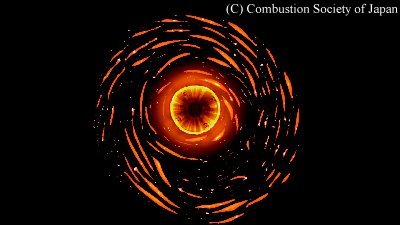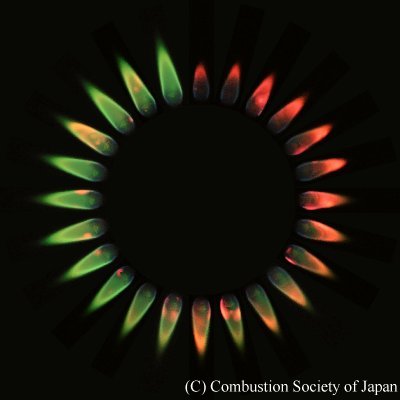Photo Contest
2019 Photo Contest -Beautiful Flames- The HIGHEST AWARD

Flame eye
MASUDA, Masashi 1, MIZOGUCHI, Tetsuya1, MATSUOKA, Tsuneyoshi1, NAKAMURA, Yuji1, KUWANA, Kazunori 2
1 Toyohashi University of Technology
2 Yamagata University
Explanation
When a thin paper burns in a narrow channel, a spreading flame breaks-up and forms a complicated, finger-like pattern due to instability. The fingering pattern can be controlled by adjusting experimental parameters such as channel height and oxidizer flow rate. This picture illustrates a unique spiral pattern of flame spread over a disk-shaped filter paper. The circular flame in the center is an igniter and the surrounding red lines are the rotating flame after ignition. Multiple photographs are superimposed to clearly visualize their paths, namely the spiral pattern.
2019 Photo Contest -Beautiful Flames- The MERIT AWARD

Broom star
WATANABE, Yusuke1, TSURUDA Takashi1, DAITOKU, Tadafumi1
1 Akita Prefectural University
Explanation
Magnesium is a metal that burns with intense luminescence. For this reason, we used the ND400 filter, which reduces the light intensity to 1/400. The ignited magnesium ribbon burns and spreads vigorously from the lower end. The situation seems to represent the meteorite's entry into the atmosphere.
2019 Photo Contest -Beautiful Flames- The MERIT AWARD

Discoloring sunflower
GUO, Feng1, OZAKI, Yu1, HASHIMOTO, Nozomu1, FUJITA, Osamu1
1 Hokkaido University
Explanation
This photograph shows 24 sequence images of a wick flame with 1 second interval following clockwise arrangement. The flame was generated by a wick burner under constant external flow of 10 cm/s. The fuel was dimethyl carbonate (DMC) with addition of 1 mole/L lithium tetrafluoroborate (LiBF4), an simplified fomulation of electrolyte used in lithium-ion battery. The cotton wick used was 7 mm in exposed length and 5 mm in diameter. The liquid level of the fuel was fixed during combustion to ensure the wick saturation. The oxygen concentraion of the external flow is 21 vol% in O2/N2 mixed gas. Initially, a red flame was generated after ignition (0’o clock direction); then the flame grew slightly with the color change; after 23s the flame became green. The red light was referred to the emission of lithium, and green light was the referred to the emission of boron. As the combustion proceeded, the lithium radicals were captured to form the solid comsbution products (LiF), which led to the flame discoloring. By arranging the transition process, a discoloring sunflower is presented. The detailed information about this flame is available in the following paper.
Feng Guo, Yu Ozaki, Katsunori Nishimura, Nozomu Hashimoto, Osamu Fujita, Combustion and Flame 213 (2020) 314-321, DOI: https://doi.org/10.1016/j.combustflame.2019.12.001